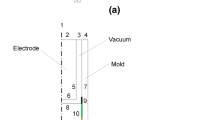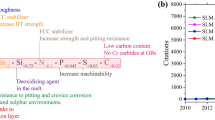Abstract
In order to solve the problems of flow field divergence, short circuit, and poor forming precision in electrochemical machining (ECM) large-diameter special-shaped inner spiral tube with pull reverse flow-cathode structure, a pull downstream cathode structure is proposed which has the function of changing working teeth and converging electrolyte flow field. The gap flow field simulation model was established, and then comparing and analyzing the gap flow field between pull downstream cathode model and the pull reverse flow cathode model. The simulation results show that pull downstream cathode structure is better than pull reverse flow-cathode structure in the gap electrolyte velocity, pressure, and streamline under the condition of 15 m/s electrolyte inlet velocity and electrolyte outlet pressure with atmospheric pressure. We also analyzed the stress and displacement of these two different cathode structures. The simulation results show that the maximum stress is 0.350 MPa and the maximum displacement is 4.275 × 10−5 mm with pull downstream cathode. However, the maximum stress of traditional pull reverse flow cathode is 0.428 MPa and the maximum displacement is 5.6355 × 10−5 mm. Finally, under the conditions of 12 V, 20 mm/min cathode feed speed, 15 wt% NaCl electrolyte with temperature 30 °C, and inlet pressure 1.5 MPa, the 2000 mm qualified sample was machined stably and reliably by pull downstream cathode. It indicates that it is feasible to machining large-diameter special-shaped inner spiral tube with the new pull downstream cathode structure.
Similar content being viewed by others
References
Fan ZJ, Yang S, Tang L (2012) Applications and developments of electrochemical machining. J Xi'an Technol Univ 32(10):775–784 (in Chinese)
Dhobe SD, Doloi B, Bhattacharyya B (2011) Surface characteristics of ECMed Ttitanium work samples for biomedical applications. Int J Adv Manuf Technol 55(1–4):177–188
Burger M, Koll L, Werner EA, Platz A (2012) Electrochemical machining characteristics and resulting surface quality of the nickel-base single-crystalline material LEK94. J Manuf Process 14(1):62–70
Holstein N, Krauss W, Konys J (2011) Development of novel tungsten processing technologies for electrochemical machining (ECM) of plasma facing components. Fusion Eng Des 86(9–11):1611–1615
Qu NS, Fang XL, Zhang YD, Zhu D (2013) Enhancement of surface roughness in electrochemical machining of Ti6Al4V by pulsating electrolyte. Int J Adv Manuf Technol 69(9–12):2703–2709
Zhu D, Zhu D, Xu Z (2012) Optimal Design of the Sheet Cathode using W-shaped electrolyte flow mode in ECM. Int J Adv Manuf Technol 62(1–4):147–156
Tang L, Li B, Yang S, Duan QL, Kang BY (2014) The effect of electrolyte current density on the electrochemical machining S-03 material. Int J Adv Manuf Technol 71(9–12):1825–1833
Tang L, Guo YF (2013) Experimental study of special purpose stainless steel on electrochemical machining of electrolyte composition. Mater Manuf Process 28(4):457–462
Lu YH, Liu K, Zhao DB (2011) Experimental investigation on monitoring interelectrode gap of ECM with six-axis force sensor. Int J Adv Manuf Technol 55(5–8):565–572
Asokan P, Kumar RR, Jeyapaul R, Santhi M (2008) Development of multi-objective optimization models for electrochemical machining process. Int J Adv Manuf Technol 39(1–2):55–63
Mukherjee R, Chakraborty S (2013) Selection of the Optimal Electrochemical Machining Process Parameters Using Biogeography-based Optimization Algorithm. Int J Adv Manuf Technol 64(5–8):781–791
Van Damme S, Nelissen G, Van Den Bossche B, Deconinck J (2006) Numerical model for predicting the efficiency behavior during pulsed electrochemical machining of steel in NaNO3. J Appl Electrochem 36(1):1–10
Tang L, Yang S (2013) Experimental investigation on the electrochemical machining of 00Cr12Ni9Mo4Cu2 material and multi-objective parameters optimization. Int J Adv Manuf Technol 67(9):2909–2916
Xu JW, Yun NZ, Tang YX, Rajurkar KP (2005) The modelling of NC-electrochemical contour evolution machining using a rotary tool-cathode. J Mater Process Technol 159(2):272–277
Qu NS, Xu ZY (2013) Improving machining accuracy of electrochemical machining blade by optimization of cathode feeding directions. Int J Adv Manuf Technol 68(5–8):1565–1572
Qu NS, Fang XL, Li W, Zeng YB, Zhu D (2013) Wire electrochemical machining with axial electrolyte flushing for titanium alloy. Chin J Aeronaut 26(1):224–229
Zhang H, Xu JW (2010) Modeling and experimental investigation of laser drilling with jet electrochemical machining. Chin J Aeronaut 23(4):454–460
Zhang Z, Feng Q, Cai M, Huang L, Jiang Y (2015) Research on stress-etching complex microstructure of aluminum alloy in laser electrochemical machining. Int J Adv Manuf Technol 81(9–12):2157–2165
Tang L, Gan WM (2014) Experiment and simulation study on concentrated magnetic field-assisted ECM S-03 special stainless steel complex cavity. Int J Adv Manuf Technol 72(5–8):685–692
Zhu HT, Hao WX, Li C, Ding QW (2018) Simulation on flow control strategy of synthetic jet in a vertical axis wind turbine. Aerosp Sci Technol 77:439–448
Purcar M, Dorochenko A, Bortels L, Deconinck J, Van Den Bossche B (2008) Advanced CAD integrated approach for 3D electrochemical machining simulations. J Mater Process Technol 203(1):58–71
Pattavanitch J, Hinduja S, Atkinson J (2010) Modelling of the electrochemical machining process by the boundary element method. CIRP Ann Manuf Technol 59(1):243–246
Wang MH, Zhu D (2009) Simulation of fabrication for gas turbine blade Turbulated cooling hole in ECM based on FEM. J Mater Process Technol 209(4):1747–1751
Tang L, Gan WM (2014) Utilization of flow field simulations for cathode design in electrochemical machining of aerospace engine blisk channels. Int J Adv Manuf Technol 72(9–12):1759–1766
Fan ZJ, Yang F, Zhao G (2009) The optimization of parameters and cathode shape in ECM for mixture rifle. rifle. J Xi'an Technol Univ 29(5):428–431 (in Chinese)
Mahdavinejad R, Hatami M (2008) On the AppSlication of electrochemical machining for inner surface polishing of gun barrel chamber. J Mater Process Technol 202(1):307–315
Mahdavinejad R, Hatami M (2008) ECM rifling tool design and manufacturing. Iran J Sci Technol B 32(4):341–352
Tang L, Fan ZJ (2008) Simulation of NC machining for the rifle of artillery tube. J Xi'an Technol Univ 2:119–122 (in Chinese)
Tang L, Gan WM, Fan ZJ, Yang S (2014) Gun Tube Rifling Electrochemical Machining Cathode Design and Experiment Study. International Conference on Mechatronics, Electronic, Industrial and Control Engineering MEIC: 828–831
Tang L, Fan ZJ, Zhao GG, Yang F, Yang S (2016) High Aspect Ratio Deep Spiral Tube Electrochemical Machining Technology. 18th CIRP Conference on Electro Physical and Chemical Machining 42:407–411
Jia JL, Liu JH, Wang X (2015) Experimental investigation on the inner cavity of gun barrel chamber in electrochemical machining. IJCA Journal 8(4):169–180
Liu GX, Luo HP, Zhang YJ, Qian J, Liu JW, Liu CH (2016) Pulse electrochemical machining of large lead ball nut raceway using a spherical cathode. Int J Adv Manuf Technol 85(1–4):191–200
Wang M, Peng W, Yao C, Zhang Q (2010) Electrochemical machining of the spiral internal turbulator. Int J Adv Manuf Technol 49(9–12):969–973
Uchiyamaa M, Tomohiro H (2018) Machining of small curved hole using electrochemical machining process. 19th CIRP Conference on Electro Physical and Chemical Machining 68(1):694–698
Wen GZ, Jin J, Li O, Pang ZH (2013) Electrochemical machining technology design of even wall thickness screw drill stator. Oil Field Equip 42(4):33–39 (in Chinese)
Funding
This work was financially supported by Shaanxi Provincial Education Department service local special plan project (Grant No. 17JF010), supported by Jiangsu Key Laboratory of Precision and Micro-Manufacturing Technology, Key Laboratory of science and technology innovation project of Shaanxi Province (Grant No. 2014SZS20-Z01, No. 2014SZS20-P05, No. 2014SZS20-K03), and the Open Research Fund Program of Shaanxi Key Laboratory of Non-Traditional Machining (No. 2015SZSj-61-6, No.ST-12009, No.ST-15002).
Author information
Authors and Affiliations
Corresponding author
Additional information
Highlights
• Gap flow field is a critical factor for ECM large-diameter special-shaped inner spiral tube.
• The pull downstream cathode structure was succeeded in solving the problems of short circuit and flow field divergence.
• The simulation results show that pull downstream cathode structure is better than traditional pull reverse flow-cathode structure.
• The new type pull downstream cathode can effectively reduce the problem of excessive force on the machine tool and improve the machining precision.
• The length of 2000 mm large-diameter special-shaped spiral tube sample was successfully machined by the pull downstream cathode.
Rights and permissions
About this article
Cite this article
Tang, L., Feng, X., Zhai, K.G. et al. Gap flow field simulation and experiment of electrochemical machining special-shaped inner spiral tube. Int J Adv Manuf Technol 100, 2485–2493 (2019). https://doi.org/10.1007/s00170-018-2865-1
Received:
Accepted:
Published:
Issue Date:
DOI: https://doi.org/10.1007/s00170-018-2865-1




